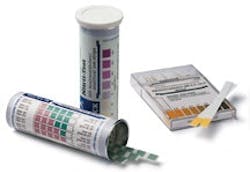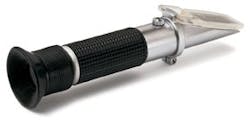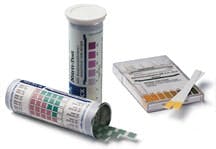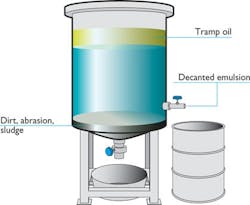Make your metalworking fluid work as hard as the machines it serves
They're in nearly every plant: the coolants that lubricate and cool drilling, milling and turning operations. The problem is that the nature of the coolant changes over time. At first, it performs well, but gradually it loses effectiveness, and eventually it must be replaced.
Coolant emulsions respond well to maintenance, especially when done early, often and regularly. Add to that the benefits of in-house recycling, and the incentives for nurturing coolants along become compelling.
When a coolant is maintained properly, machine tools may operate for months on the same charge. The direct costs associated with consumption and disposal are reduced. The indirect costs associated with health, the work environment, downtime, scrap and machine damage are also lowered. What's more, a constant process capability requires fewer machine adjustments. It's not surprising that many shops maintain coolants with the discipline afforded million-dollar machine tools.
Sump maintenance
Coolants are emulsions prepared by diluting a concentrate with 85 percent to 95 percent water. The concentrate contains 30 percent to 60 percent mineral or vegetable oil, which serves as the carrier for 15 to 20 other ingredients that contribute to machining performance and the coolant's stability.
The rigors of the metalworking processes and the machine tool environment eventually take their toll on the emulsion. The temperature in the cutting zone, the agitation in the fluid system, tramp oils seeping into the sump, the bacterial activitythey all add up.
But an ounce of prevention is worth more than a pound of cure when it comes to keeping coolants stable and long-lasting, especially when the effort is readily within the ability of shop personnel to perform. Key steps are simplestart with the right fluid, properly prepared; emphasize cleanliness; monitor carefully and take corrective action when needed.
Get a good start
Machining performance is the obvious selection criterion, but also consider the fluid's ability to reject tramp oil, tolerate changes in pH and water hardness and resist bacterial proliferation.
Mixing the emulsion requires potable water, not plant process water. If the water is softwhich encourages foaminguse a coolant concentrate formulated for soft water or increase the water hardness by adding food-grade calcium. If the water is hardwhich causes most emulsions to separateinstall a deionizer to remove dissolved minerals.
Achieving emulsions having sub-micron oil droplets suspended in the water makes for a homogenous and stable fluid, minimizes concentrate consumption and promotes efficient machining. It pays to invest in good mixing equipment.
Watch contaminants
Good housekeeping is half the job. At the top of the to-do list is dealing with tramp oil.
When it mixes with the coolant emulsion, tramp oil quickly begins to interfere with machining performance and the general work environment. Once a secondary emulsion forms, which is particularly tricky to prevent on machines equipped with high-pressure coolant systems, the coolant can't be saved.
The cure is to keep seals in good condition and use compatible lube oils. Effective coolants reject tramp oil, causing it to separate out quickly and float. During idle periods, a suction device or skimmer removes floating tramp oil.
Accumulations of chips and swarf on the tank bottom can produce a highly corrosive, sheltered environment for bacteria and impede biocide treatment. These mounds also displace valuable coolant volume with adverse implications on temperature control and stability. Remove the sludge often with sump suckers, scrapers or other techniques.
Regulate concentration
Evaporation, splashing and dragout constantly change the concentration and volume in the sump. The concentration can increase by several percentage points in a single day, quickly drifting off target.
If adjusted improperly and allowed to move outside the coolant's operating range, machining performance and tool life quickly become unacceptable. Above the range, the emulsion loses cooling capacity, begins to smoke, foams and retains residues. Below the range, pH and corrosion inhibition drop.
Daily monitoring using an optical refractometor and recording the results is a must (see Figure 1). When regulating concentration and level, always add mixed coolant to the sump, not just water.
Figure 1. An optical refractometer monitors lube concentration
Check the pH
Consistent pH is a sign of a healthy and stable coolant. Changes can point to any number of ailments: high concentration of minerals and other contaminants, bacterial activity or fluctuations in concentration, to name a few. Historical pH values provide clues about appropriate remedies to coolant aging.
A coolant with a pH in the range of 8 to 9 is ideal. Lower values (increasingly acidic) indicate biological activity and physical and chemical instability. The fluid begins to smell and corrodes ferrous surfaces. Higher pH may introduce skin irritation, staining of non-ferrous metal, foaming, excessive washing action on machine surfaces (including paint removal), incompatibility with plastic and other symptoms.
Measuring pH daily is an excellent coolant health check. Simple litmus paper dip strips (see Figure 2) give a good indication, but hand-held electronic pH meters are more precise. Add pH boosters and rust inhibitors to treat symptoms while investigating the root cause. If the pH remains low, it's best to clean the sump and recharge the machine.
Figure 2. Test papers monitor pH and other lube variables.
Living with bacteria
Not every sump has problem bacteria. The difficulty lies in the matter of degree and the type of bug. Bacteria are everywhere, including machine tool sumps, and their presence is not the problem. Rampant proliferation is. More often than not, proliferation correlates to the overall health of the fluid system.
Odor and sludge formation are telltale signs, as bacterial decomposition products contribute to a septic and toxic environment. In time, pH decreases, health issues surface, the emulsion separates and filtration becomes more difficult.
Frequent readings of biological activity are valuable. A dip slide test provides a good approximation of bacterial activity within 24 to 48 hours. A laboratory plate count test is more accurate, but takes longer to produce results. Treatmentusually administering biocides to suppress growthis a balancing act. Strong, infrequent dosing tends to be most effective in minimizing mutant strains, but it can also cause health concerns and induce fungus development.
Simple coolant aeration effectively fights anaerobic bacteria.
But biological stability can also be achieved without biocides. Some coolants are formulated to tolerate high levels of bacteria. This is possible because in reasonably clean machine tool sumps, bacterial proliferation subsides to a level safe to people and processes. Furthermore, most bacteria are perfectly harmless (indeed, often essential) and naturally overwhelm and neutralize pathogenic bacteria.
Recycling closes the loop
After months or years, sump-side maintenance stops being effective and coolant replacement becomes the only option. Intermittent recycling, however, can stretch the coolant's productive life. The benefits become particularly attractive for premium coolants, and when machine shop operations permit using a universal or primary coolant.
Inherently stable emulsions tolerate recycling that can remove nearly every type of contaminant, even submicron particulates and bacteria. Continuous in-line designs serve central fluid systems. Batch configurations may take the form of a large central reclamation facility or a portable recycling unit moved among machines to recycle one sump at a time.
Skimming equipment, often used with coalescing and flotation techniques, speeds tramp oil removal. Hydrocyclones and mechanical filterswire mesh, belt-type and vacuum designsremove chips and swarf. A centrifuge is arguably the most costly and elaborate recycling technique, but it removes virtually every contaminant.
A good middle-of-the-road approach is decanting (see Figure 3). It's quite effective and the most economical approach. When left undisturbed, tramp oil floats to the top while particulates, dirt and sludge gravitate to the bottom. After three to five days, the decanted coolant is removed from the middle.
Figure 3. Simple decanter system
Maintaining coolant health is a sound practice. It saves money and is better for the equipment, the environment and the health of employees.
Virgil Copple is maintenance supervisor of production equipment at Markem Corporation in Keene, N.H. Ulrich Krahenbuhl is president of Blaser Swisslube Inc., Goshen, N.Y. He can be reached at 845-294-3200.
Figures: Blaser Swisslube Inc.




